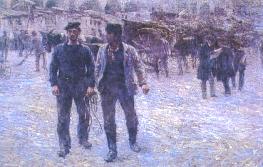
Excerpt from "The soul of man under Socialism"
by Oscar Wilde
A fresh mode of Beauty is absolutely distasteful to them [public], and whenever it appears they get so angry and bewildered that they always use two stupid expressions - one is that the work of art is grossly unintelligible; the other, that the work of art is grossly immoral. What they mean by these words seems to me to be this. When they say a work is grossly unintelligible, they mean that the artist has said or made a beautiful thing that is new; when they describe a work as grossly immoral, they mean that the artist has said or made a beautiful thing that is true. The former expression has reference to style; the latter to subject-matter. But they probably use the words very vaguely, as an ordinary mob will use ready-made paving-stones. […]
Perhaps, however, I have wronged the public in limiting them to such words as "immoral," "unintelligible," "exotic," and "unhealthy." There is one other word that they use. That word is "morbid." They do not use it often. The meaning of the word is so simple that they are afraid of using it. Still, they use it sometimes, and, now and then, one comes across it in popular newspapers. It is, of course, a ridiculous word to apply to a work of art. For what is morbidity but a mood of emotion or a mode of thought that one cannot express? The public are all morbid, because they never find expression for anything. The artist is never morbid. He expresses everything. He stands outside his subject, and through its medium produces incomparable and artistic effects. To call an artist morbid because he deals with morbidity as his subject-matter is as silly as if one called Shakespeare mad because he wrote King Lear.
[…]
Within the last few years two other adjectives, it may be mentioned, have been added to the very limited vocabulary of art abuse that is at the disposal of the public. One is the word "unhealthy," the other is the word "exotic." The latter merely expresses the rage of the momentary mushroom against the immortal, entrancing, and exquisitely lovely orchid. It is a tribute, but a tribute of no importance. The word "unhealthy," however, admits of analysis. It is a rather interesting word. In fact, it is so interesting that the people who use it do not know what it means.
What does it mean? […] In fine, a healthy work of art is one that has both perfection and personality. Of course, form and substance cannot be separated in a work of art; they are always one. But for purposes of analysis, and setting the wholeness of aesthetic impression aside for a moment, we can intellectually so separate them. An unhealthy work of art, on the other hand, is a work whose style is obvious, old-fashioned, and common, and whose subject is deliberately chosen, not because the artist has any pleasure in it, but because he thinks that the public will pay him for it. In fact, the popular novel that the public calls healthy is always a thoroughly unhealthy production; and what the public call an unhealthy novel is always a beautiful and healthy work of art.






































